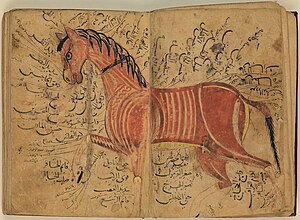
Back الفروسية في التاريخ الإسلامي Arabic Furûsiyya Catalan Furusiyya Spanish Furûsiyya French פורוסייה HE Furusiyya Italian Farys Polish فروسيہ PNB Furusiyya SIMPLE فروسيہ Urdu
Furūsiyya (Arabic: فروسية; also transliterated as furūsīyah) is an Arabic knightly discipline and ethical code developed in the Middle Ages.[1] It was practised in the medieval Muslim world from Afghanistan to Muslim Spain, and particularly during the Crusades and the Mamluk period.[2] The combat form uses martial arts and equestrianism as the foundation.[3][4]


The term furūsiyya is a derivation of faras (فرس) "horse", and in Modern Standard Arabic means "equestrianism" in general. The term for "horseman" or "cavalier" ("knight") is fāris (فارس),[5] which is also the origin of the Spanish rank of alférez.[6] The Perso-Arabic term for "Furūsiyya literature" is faras-nāma or asb-nāma.[7] Faras-nāma is also described as a small encyclopedia about horses.[8]
The three basic categories of furūsiyya are horsemanship, including veterinary aspects of proper care for the horse (hippology) and the proper riding techniques (equestrianism), mounted archery, and jousting. Ibn Qayyim al-Jawziyya adds swordsmanship as a fourth discipline in his treatise Al-Furūsiyya (1350).[9] Ibn Akhi Hizam also cited that there are three fundamentals to the furūsiyya: horse mastery, proficiency in handling all types of weapons, and bravery.[5]
- ^ Jalali, Ali Ahmad (15 December 2021). Afghanistan: A Military History from the Ancient Empires to the Great Game. University Press of Kansas. ISBN 978-0-7006-3263-3.
- ^ Jalali, Ali Ahmad (15 December 2021). Afghanistan: A Military History from the Ancient Empires to the Great Game. University Press of Kansas. ISBN 978-0-7006-3263-3.
- ^ Jalali, Ali Ahmad (15 December 2021). Afghanistan: A Military History from the Ancient Empires to the Great Game. University Press of Kansas. ISBN 978-0-7006-3263-3.
- ^ "FURUSIYYA- ARABIA - MartialAsk". 23 December 2017.
- ^ a b Daniel Coetzee, Lee W. Eysturlid, Philosophers of War: The Evolution of History's Greatest Military Thinkers (2013), p. 59, 60, 63. "Ibn Akhī Hizām" ("the son of the brother of Hizam", viz. a nephew of Hizam Ibn Ghalib, Abbasid commander in Khurasan, fl. 840).
- ^ Simon Barton, The Aristocracy in Twelfth-century León and Castile, Cambridge (1997), 142–44.
- ^ Foundation, Encyclopaedia Iranica. "Welcome to Encyclopaedia Iranica". iranicaonline.org. Retrieved 2022-10-17.
- ^ Gommans, J. J. L. (2002-08-15). Mughal Warfare: Indian Frontiers and Highroads to Empire 1500–1700. Routledge. ISBN 978-1-134-55275-7.
- ^ "Arab epic heroes and horses". Halle an der Saale: 29. Deutscher Orientalistentag. Archived from the original on July 18, 2011.
Furusiyya covers four disciplines: the tactics of attack and withdrawal (al-karr wa-l-farr); archery; jousts with spears; duels with swords. [...] Only the Muslim conquerors and the knights of the faith have fully mastered these four arts.
© MMXXIII Rich X Search. We shall prevail. All rights reserved. Rich X Search